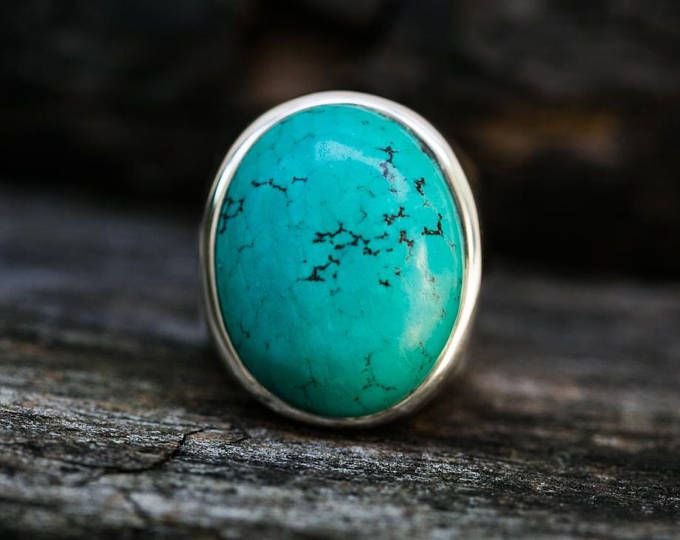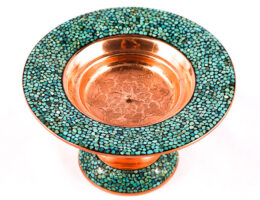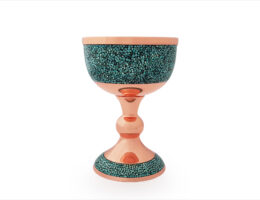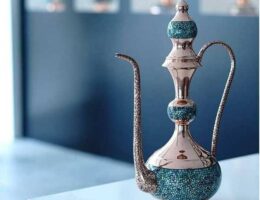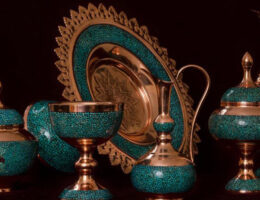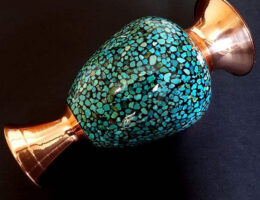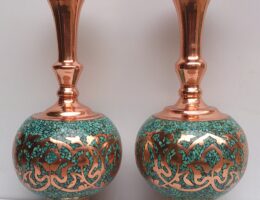IRAN ART EXHIBITION: “TURQUOISE” AN ANCIENT GEMSTONE
Turquoise was one of the world’s first gemstones. The world’s oldest gem mines were developed before the times of Ancient Egypt, in the southern part of the Sinai peninsula around 6000 BC.
Persian turquoise mines have a similar age. Mining of the eye-catching blue stone started here some 5000 years ago – or even 7000 years ago! While the best Egyptian stones were exhausted and have much lower quality now, the mines near Nishapur are active up to this day. Even more – geologists have assessed that with the current tempo the mining can continue here for 200 more years!
For several thousand years the mine in Nishapur was the main supplier of this gem in the Old World.
Over these millennia turquoise from Nishapur has left a profound influence on the art and cultural values of Persia. People learned to imitate the sky-blue stone with glass, enamel, colors. Domes of the palaces and mosques, tiles in basins, garments, and jewelry were covered with diverse materials in turquoise color.
Turkish stone
When the Persian turquoise was imported to Europe in the 17th century, it was supplied through Turkey. French named the stones simply “turquois” – “Turkish”. Thus the Europeans (and Americans and many others) now call the stone in the name of a country that has rather little to do with turquoise.
If Persians were obsessed with turquoise, Europeans were too. Stones of very high quality were not much cheaper than brilliants or emeralds, especially during the Napoleonic times.
Nowadays the market is flooded with the turquoise of rather low quality, there are lots of imitations as well. Most people have never seen a high-quality turquoise – it is rare. But it exists, and the best one still is mined in the old mines near Nishapur.

Ma’dan – mining village
The stones are found in weathered trachyte from the Eocene period on the contact with limonite and sandstone.
As it is usual, at first people gathered stones on the ground. When the blue stones in the scree ended, they dug in the cliffs. The Ali-Mersai mountain was favorable – veins of the stone were everywhere. Over the last centuries, the mountain has been crisscrossed by mines, villages of miners have grown right at the entrance in the mines. The best-known mine is in a village named simply “the Mine” – Ma’dan.
Some of the best local mines are:
• Khak Ghermez – here are found stones of mild blue color without inclusions. The whole stone has the same color.
• Abo Ishaghi or Abdo Al’Razaqi – exhausted mine where the highest quality stones were found.
Every year some 30 – 40 tons of stones are mined in this area, some 15 – 20 percent are cut into gems. Unfortunately, mining has not brought much prosperity to the people. As with any mining, this is hard and often hazardous work, which up to this day is continued with rather primitive methods.
Processing and marketing
IRAN ART EXHIBITION: Most of the mined turquoise is further processed in three nearby towns – Firoozeh, Nishapur, and Mashhad. This is a fairly important business for the local economy with thousands of people involved. Most of the stones are exported to the Gulf Countries and East Asia.
The Persian turquoise traditionally is classified into three quality groups:
• Anqushtari (Angusthari) – the highest quality, with a rich blue color.
• Barkhaneh – somewhat less quality, with more markings and matrix.
• Arabi – stones with pale blue or green shade, with ugly speckles.
A turquoise of high value has an intense blue color – the darker the better. It is smooth and does not have inclusions.
One of the most sought varieties is the “Sleeping Beauty Turquoise” with absolutely flawless coloration. The Persian “Sleeping Beauty” should not be confused with the American “Sleeping Beauty Turquoise” from Arizona – which also is a high-quality stone.
